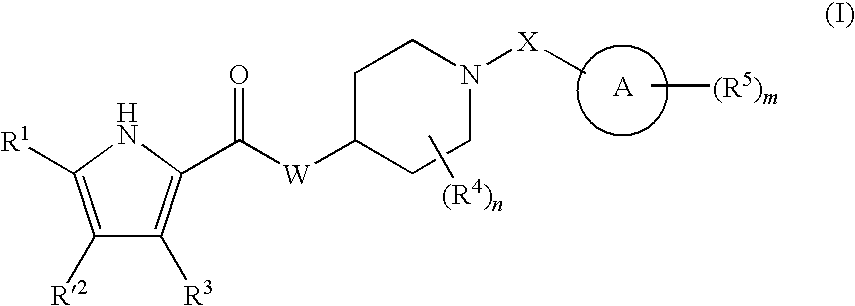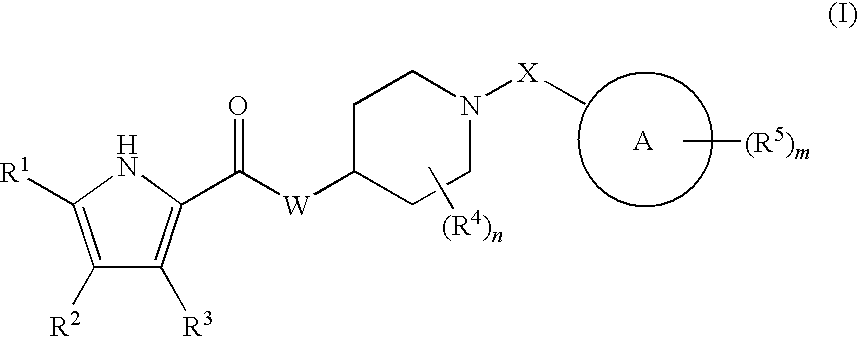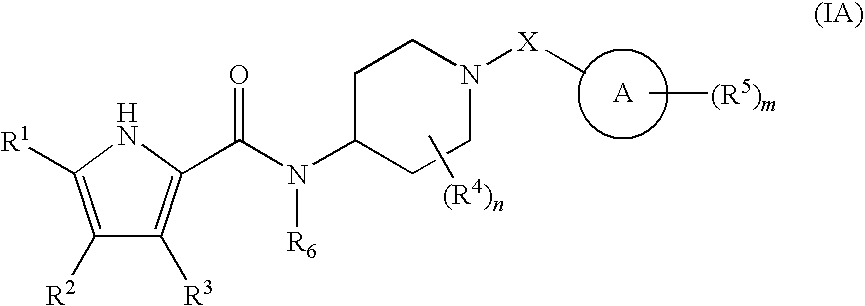Antibacterial piperdine derivatives
a piperdine derivative and antibacterial technology, applied in the field of compounds, can solve the problems of resistance generated, strains against which currently available antibacterial agents will be ineffective, and agents less and less effective in the treatment of gram-positive pathogens
- Summary
- Abstract
- Description
- Claims
- Application Information
AI Technical Summary
Benefits of technology
Problems solved by technology
Method used
Image
Examples
example 1
Cis(±)methyl 2-(4-{[(3,4-dichloro-5-methyl-1H-pyrrol-2-yl)carbonyl]amino}-3-methoxypiperidin-1-yl)-1,3-thiazole-5-carboxylate
[0311]
Method 1
[0312]Cis(±)3,4-dichloro-N-(3-methoxypiperidin-4-yl)-5-methyl-1H-pyrrole-2-carboxamide (Intermediate 50; 380 mg), methyl 2-bromo-1,3-thiazole-5-carboxylate (276 mg), were dissolved in anhydrous DMA (5 ml). DIEA (216 μl) was added and the mixture was heated at 120° C. for 7 hours (h). The mixture was diluted with EtOAc, washed well with citrate buffer, water, brine, and dried over Na2SO4. The organic phase was concentrated in vacuo to give the title compound as a brown solid (337 mg).
Method 2
[0313]Alternatively the title compounds were prepared using a Smith Microwave Synthesizer by subjecting the reaction mixture to single-mode microwave at 150° C. for 30 minutes (min.) or until the reaction is complete as judged by LCMS, using polar aprotic solvent such as DMA, NMP or 1-butyl-3-methyl imidazolium-tetrafluoroborate as reaction solvents. MS (ES) M...
examples 2-33
[0314]The following Examples were prepared by the procedure described in Example 1 from the starting materials (SM) indicated.
ExCompoundDataSM2methyl 2-((3S,4R)-4-{[(3,4-MS (ES) MH+: 447 forIntermediate 51 anddichloro-5-methyl-1H-C17H20Cl2N4O4S; NMR: 1.87methyl 2-bromo-1,3-pyrrol-2-(m, 2H), 2.05 (m, 2H), 2.27 (s,thiazole-5-yl)carbonyl]amino}-3-3H), 3.01 (m, 2H), 3.25 (s,carboxylatemethoxypiperidin-1-yl)-1,3-3H), 3.65 (m, 1H), 3.83 (s,thiazole-5-carboxylate3H), 4.12 (m, 1H), 4.46 (m,2H), 7.40 (d, 1H), 8.00 (s, 1H),12.38 (s, 1H)3methyl 2-((3R,4S)-4-{[(3,4-MS (ES) MH+: 447 forIntermediate 52 anddichloro-5-methyl-1H-C17H20Cl2N4O4S; NMR: 1.89methyl 2-bromo-1,3-pyrrol-2-(m, 2H), 2.11 (m, 2H), 2.23 (s,thiazole-5-yl)carbonyl]amino}-3-3H), 3.33 (m, 2H), 3.46 (s,carboxylatemethoxypiperidin-1-yl)-1,3-3H), 3.59 (m, 1H), 3.85 (s,thiazole-5-carboxylate3H), 4.09 (m, 1H), 4.46 (m,2H), 7.31 (d, 1H), 7.92 (s, 1H),12.30 (s, 1H)4Cis(±)methyl 2-(4-{[(3,4-MS (ES) MH+: 414 forIntermediate 56 anddifluoro-5...
example 34
Cis(±)methyl 4-(aminocarbonyl)-2-(4-{[(4-chloro-5-methyl-1H-pyrrol-2-yl)carbonyl]amino}-3-methoxypiperidin-1-yl)-1,3-thiazole-5-carboxylate
[0315]Cis(±)methyl-2-(4-{[(4-chloro-5-methyl-1H-pyrrol-2-yl)carbonyl]amino}-3-methoxypiperidin-1-yl)-4-{[(1-methyl-1-phenylethyl)amino]carbonyl}-1,3-thiazole-5-carboxylate (Example 21; 0.058 g, 0.1 mmol) was dissolved in equal volumes of TFA and DCM. The reaction was heated in a sealed tube to an external temperature of 85° C. overnight. The reaction mixture was concentrated to remove the DCM and excess TFA. The residue was partitioned with EtOAc and NaHCO3 and the organic extracts were dried with MgSO4 and concentrated to a yellow solid (0.050 g, 100%). MS (ES) MH+: 456 for C18H22ClN5O5S.
PUM
| Property | Measurement | Unit |
|---|---|---|
| Electrical conductance | aaaaa | aaaaa |
| Temperature | aaaaa | aaaaa |
| Volume | aaaaa | aaaaa |
Abstract
Description
Claims
Application Information
 Login to View More
Login to View More - R&D
- Intellectual Property
- Life Sciences
- Materials
- Tech Scout
- Unparalleled Data Quality
- Higher Quality Content
- 60% Fewer Hallucinations
Browse by: Latest US Patents, China's latest patents, Technical Efficacy Thesaurus, Application Domain, Technology Topic, Popular Technical Reports.
© 2025 PatSnap. All rights reserved.Legal|Privacy policy|Modern Slavery Act Transparency Statement|Sitemap|About US| Contact US: help@patsnap.com



